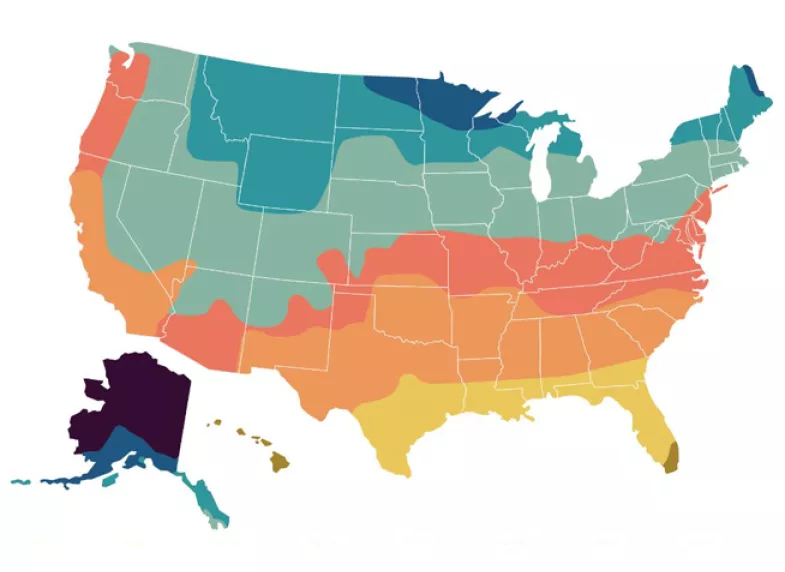Phius discovered a minor discrepancy related to climate data in the standard-setting process. Therefore, we have published slightly adjusted standard criteria for the performance and prescriptive paths. An overview on the reasoning for the adjustment follows:
The Phius standards are derived from a multi-step process:
Step 1: Run building optimization studies for buildings of varying sizes, unit densities, occupant densities, and for climates that cover the full range of possibilities in North America.
Step 2: For the performance path, model those optimal cases in WUFI Passive and note the space conditioning performance results. For the prescriptive path, note the enclosure and passive upgrade measures of the optimal buildings.
Step 3: Run statistical analysis on the results of Step 2 to determine the relationship between the optimization input factors (climate, building size, densities, etc.) and the outputs (performance results or passive upgrade measures).
Step 4: Build the resulting formulas from Step 3 into the Performance Criteria calculator and Prescriptive Checklist and Snapshot.
Step 3 above required gathering climate data for all of Phius’ climate data locations. For these studies and target setting, the climate data comes from two sources that were paired: Phius Climate Data (TMY3 in Meteonorm) and ASHRAE Climate Data. The two sources provide different types of data, both of which were important factors in setting the criteria.
In order to combine the data, Phius keyed off of two items:
- The name of the weather station
- The 6-digit number the station is coded with the ‘WMO’ (World Meteorological Organization) number
The WMO numbers can change over time, so a station name match was first used to combine data for more than 90 percent of the data sets. For the remaining, WMOs were used when possible, and other times it took manual lookups of the TMY3 station longitude and latitude against the ASHRAE data and nearby stations were used.
We recently noticed a discrepancy between the two weather stations in Boulder, Colorado. There was a significant difference between the altitude of the Phius Climate Data set and the ASHRAE data we paired with it.
We then reviewed all of our climate data set pairings for discrepancies in altitude between the Phius data and ASHRAE Data and re-ran the pairing exercise with the WMO instead of the location name.
As a result, we found some discrepancies and necessary updates. Only a handful needed adjustments (5 percent of total locations), but these stations did affect the standards criteria set for this reason:
In Step 1, we ran our optimization for climates that cover all possibilities in North America – we had to hit each extreme to be able to interpolate in between. This means there wasn’t an even distribution of climate data sets used (optimizations for each individual climate location) but rather an even distribution of climate factors covered in the studies. So, some of the more extreme weather stations had to be used more than once because they covered one end of the range or another. Those often corresponded to the cases where the data adjustment was needed. So, although we only updated the pairing on 5 percent of our data sets, it influenced 17 percent of our optimization runs.
Therefore, we had to repeat Step 3 and Step 4 above with the adjusted climate data. The result is an updated Performance Criteria Calculator and Prescriptive Path Checklist and Snapshot.
On average, this adjustment brought a loosening of the targets relative to the originally published Phius 2021 targets (though in some locations they did tighten – this is on average). Below is a summary of the results.
|
Phius 2021 Performance Path
|
Change
|
|
Heating Demand
|
Loosened 11%
|
|
Cooling Demand
|
Loosened 8%
|
|
Heating Load
|
Loosened 9%
|
|
Cooling Load
|
Loosened 3%
|
|
Phius 2021 CORE Prescriptive Path
|
Change
|
|
Roof & Ceiling R-Value
|
Loosened 2.2%
|
|
Walls & Overhang Floor R-Value
|
Loosened 5.2%
|
|
Slab Foundations/BG Walls/Crawl Space
|
Tightened 2.2%
|
|
Ceilings of Unconditioned Basement/Pier & Beam Floors
|
Loosened 2.9%
|
|
Windows: Only 3% of locations were affected, half tightened and half loosened
|
|
E/HRV Sensible Recovery Efficiency: Only 3% of locations were affected, half tightened and half loosened.
|
It’s important to note that these are very minor updates and do not affect the performance or efficiency of any projects previously certified by Phius.

